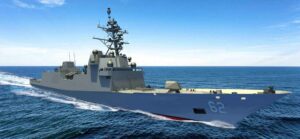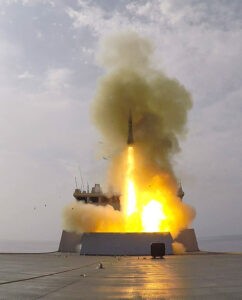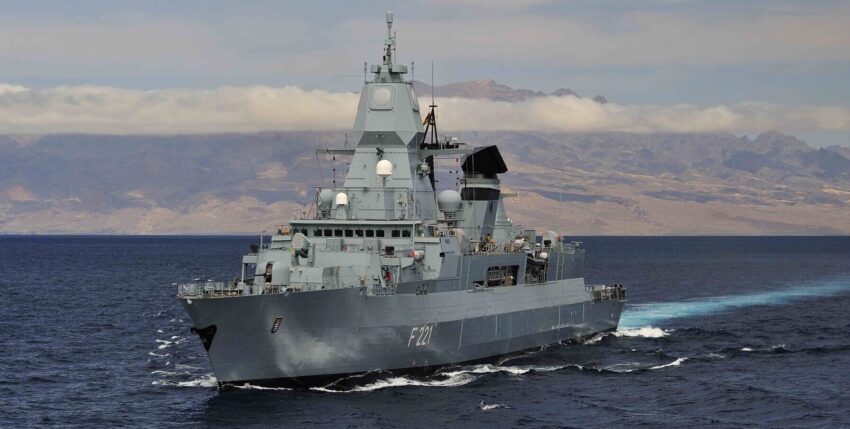The publication of the Marine 2035+ target picture provides an opportunity to think more intensively about future German air defence frigates. Active defence against ballistic missiles will play a central role.
After the end of the service life of frigates 124, which is planned between 2034 and 2036, the future frigate class 127 will contribute to the defence against ballistic missiles. In contrast to class 124, this will be achieved not only through its sensors, but in particular through its armament. In addition to BMD, it will also be capable of defence against hypersonic threats. The future class would therefore be a globally deployable weapon system for protecting a task force or theatre of operations against the entire spectrum of threats from the air.
The target picture for the navy from 2035, which was published in March 2023, envisages six frigates 127. As units specialising in anti-air warfare (AAW), they are to form the core of deep-sea battle groups for the northern flank and global deployment alongside six submarine hunting units, which the target image defines as frigates 126.
The project was kept on a low flame until February 2022, like many other future-proof armaments projects. As the Next Generation Frigate - Air Defence (NGFrig-AD) project, it kept designers and developers busy. The federal government's current budget (Federal Budget Act 2023) does not include any budget funds for Class 127. A draft of the 2024 federal budget was not yet available at the time of going to press.

TKMS could develop a version for
Developing air defence, photo: TKMS
In February 2021, Airbus was awarded the contract to investigate a "general concept for a scalable AMD testbed that can be operated over the entire service life of a Class 127 frigate. The technology field 'Ballistic Missile Defence' is to be considered in particular." This is the text on TED, the European Union's publicly accessible tendering platform.
With the advent of the new era, the availability of special Bundeswehr assets and the increased pressure on national and alliance defence, hopes were also pinned on a rapid closure of the capability gap in maritime air defence for the areas of air defence, area protection and ballistic missile defence (BMD). A military off-the-shelf solution in the form of ships and constructions available from NATO partners was recommended to speed up the realisation and gain operational and logistical synergies. The first tentative indications were directed towards the US Navy, whose USS Constellation (FFG 62), the type ship of the class of twenty missile frigates of the same name, is currently under construction. The design based on the FREMM class, a French-Italian co-production, promised rapid availability of the platform and the proven Aegis command and weapon deployment system. It had already proven itself in defence against ballistic missiles.
Other ships and designs are also available from NATO partners. In addition to the FREMM class, the Horizon class, also developed and operated by France and Italy, could also be considered. From this series, the French frigate Forbin succeeded in shooting down a hypersonic missile during the Formidable Shield manoeuvre. It was not only the S-1850M radar system, the French version of Smart-L, that proved its worth here. It was also the first use of the MBDA missile Aster 30 against a target with a speed of more than 8000 kilometres per hour. In earlier trials, the French Navy demonstrated with frigates of the same type that they can engage supersonic (3000 km/h) missiles approaching at an altitude of less than five metres above the water surface.
The Royal Netherlands Navy operates the four frigates of the De Zeven Provinciën class. This class of ship is also known as an air defence and command frigate (Luchtverdedigings- en commandofregat, LCF) and is similar in function and mission to the German Sachsen class.

In December 2022, the F 127 project was said to be at the end of analysis phase 1, and no new status has been communicated since then. With the start of analysis phase 2, extensive feasibility studies are being carried out and proposed solutions are being developed. An article authorised by the Naval Command for issue 2-2023 of our sister magazine "Europäische Sicherheit" states: "Possible solutions currently range from a bi-national cooperation with a completely new development, to an FMS case (Foreign Military Sale) for the platform and command and weapon deployment system (FÜWES), to a partial FMS case for the FÜWES. In the latter case, the platform would be built by a German shipyard and the added value would therefore remain in Germany."
At the beginning of March 2023, a report in the Kieler Nachrichten newspaper about a project by Thyssenkrupp Marine Systems (TKMS) for the F 127 attracted attention. A basic design along its Meko A 400 AMD was presented to a closed company on the Kiel Fjord. In this case, AMD stands for Air and Missile Defence. On request, the design, which is around 160 metres long, has a displacement of 10,000 tonnes, is designed for a crew of 150 and should be able to reach a speed of 32 knots. A corresponding illustration shows a two-island ship, which speaks in favour of redundancy and stability. The armament includes a 127-millimetre turret (presumably from Vulcano), rolling airframe missile (RAM) and two vertical launcher configurations - one forward and one aft of the deckhouse - which would equate to 48 bays. The sensor equipment includes a bow sonar.
Earlier publications on the F 127 stated that, in addition to RAM, the Evolved SeaSparrow Missile (ESSM) Block 2 and high-energy weapons such as a 100-kilowatt laser could also be considered for close and short-range defence. In addition to missiles for defence against threats from the air, various concepts for engaging sea and land targets over long distances are being investigated. A long-range weapon against submarines is also being considered - in line with the threat.
In earlier publications, modular equipment for the F 127 was discussed in relation to submarine hunting and other operational areas. A flex hangar and a flex tail should be able to deploy various naval warfare assets, for example small to medium-sized unmanned aerial vehicles (UAVs), a combat boat or unmanned surface vehicle (USV) up to around twelve metres in length, or alternatively several smaller types and various underwater vehicles (UUVs). The F 127 could also have a containerised modular towed sonar and other containerised mission components and compatible launch and storage systems, including sea mines.
To ensure a seamless transition from the F 124, TKMS would utilise tried and tested components. This includes not only the armament. The command and weapon deployment system in particular must fit into the timelines. The focus is therefore on Aegis. According to the Kiel-based company, it is the only system that can be realised in the period in question. The same applies to the design of the propulsion system. Codag - Combined Diesel and Gas - is envisaged. A diesel-electric propulsion system would have to be redesigned for the required maximum speed of 32 knots.
Speaking of deadlines: TKMS assumes that the order will have to be placed before 2025 in order to be able to provide the first unit in time for the planned end of life of the Sachsen class.

ballistic missiles. Photo: Marine Nationale
BMD-capable weapons
In addition to the sensors and the command and weapon deployment system, the challenges of BMD lie in the missiles that enable them. The decisive factor for the requirements and profiles is the time and place of engagement: a distinction is made between endoatmospheric and exoatmospheric.
The American Standard Missile 6 (SM-6) and Standard Missile 3 (SM-3) systems are available on the market. MBDA offers solutions against hypersonic targets (Aster 15) and for BMD (Aster 30). The Aster 30 Block 2 BMD, which is currently under development, is designed to disable ballistic missiles at a range of up to 3,000 kilometres. The EU is supporting the development of a seabased European Midcourse Interceptor (sEMDI), an endoatmospheric interceptor. The EU defence fund (European Defence Fund, EDF) has 28 million euros available for the concept phase.
In recent years, Thales Nederland has installed its Smart-L Multi-Mission (MM), a newer version of the Smart-L radar, on the Royal Netherlands Navy's De Zeven Provinciën-class frigates. It is suitable for BMD, as it enables a detection range of up to 2000 kilometres against ballistic missiles, and 480 kilometres against air targets in air defence. Thales' own Tacticos command and weapon deployment system enables BMD and defence against hypersonic missiles. In recent years, French and Dutch units have demonstrated this not only on the national stage.
The German sensor company Hensoldt is working with Elta, a subsidiary of the Israeli company IAI, to develop the TRS-4D/LR ROT air and sea surveillance radar, which will be deployed on the 124 frigate from 2025. According to the company, the radars will have the ability to detect and track ballistic missiles. Detection of small and manoeuvrable objects over more than 400 kilometres for air targets and up to 2000 kilometres for objects in earth orbit is possible.
Symbol of the turning point
The future frigate 127 is to operate in a sensor network with other sea, air, space and ground-based integrated air defence systems. As the results of the analysis phase are still pending, it remains to be seen to what extent the ships will contribute to territorial missile defence in homeland security and national defence, but also to NATO ballistic missile defence as part of alliance defence. Against the backdrop of current events and NATO's demands on Germany with regard to maritime air defence, territorial defence and defence against ballistic and hypersonic threats, this weakness in decision-making is incomprehensible. After all, the units emphasise the seriousness of Germany's commitment to the Alliance's strategic security provision. In order to realise this, however, the necessary budgetary resources must be made available. As this has not yet been the case, the schedule announced by TKMS could slip.
In addition to the time risk, there is also the question of cooperation with European partners. In December 2020, the defence ministries from Berlin and The Hague signed a declaration of intent to explore the possibility of cooperation in the construction of future air defence frigates. The signs seem to have changed. In response to a parliamentary question, State Secretary of Defence Thomas Hitschler stated in March 2023 that the ministry was keen to replace the frigate 124 "with a modern ship that is ready for deployment upon delivery" in good time. Currently, "all options for low-risk and timely provision of maritime air defence capabilities are being examined with an open mind against the background of this fundamental change in the situation".
The design of the future Class 127 from Thyssenkrupp Marine Systems would have the charm of killing several birds with one stone. Firstly, the postulate of key maritime technology would be retained. European co-operation could be demonstrated in the selection of the command and weapon deployment system. The transatlantic partnership could be underpinned by the selection of appropriate interceptor missiles.
Hans-Uwe Mergener










